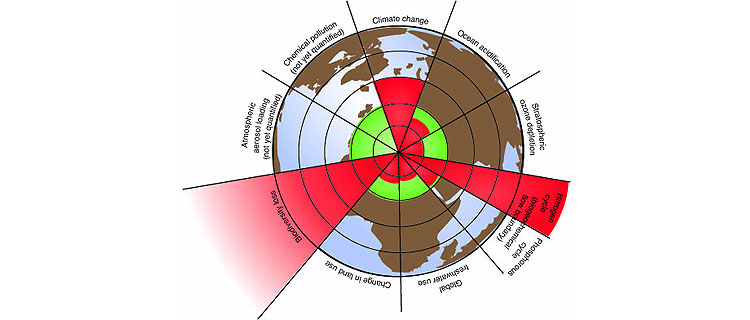
Reply in Nature
Planetary boundaries are valuable for policy
Centre researchers reply to criticism
"It is a mistake to see the setting of environmental boundaries as a call for multilateral negotiations around static limits. They are instead a bid for adaptive governance at multiple scales," write Victor Galaz, Sarah Cornell, Johan Rockström and Åsa Persson in a short comment in Nature , published 14 June 2012.
The comment is a reply to a column written by Simon L. Lewis in Nature, 23 May. In it Lewis argues that the planetary boundaries concept's focus is too narrow, that it does not distinguish between 'boundaries' and ‘thresholds', diverts political attention away from other urgent issues, and that it should do a better job in clarifying the influence of scale on different problems.
"As researchers studying the concept of planetary boundaries and its implications for governance and policy, we disagree with Lewis and conclude that his column builds on misunderstandings," says Victor Galaz.
Misunderstanding 1. Thresholds, scales and governance
Victor and colleagues from the centre have written a set of articles dealing with the governance challenges of planetary boundaries, e.g. in Current Opinion in Environmental Sustainability, Ambio and a special issue in Ecological Economics.
In these and the original planetary boundaries articles by Johan Rockström and 28 others, it is concluded that planetary boundaries are not fixed 'supply limits', but are set within a safety margin around complex thresholds that are intertwined at regional and global scales. Or as expressed in the Ecology and Society-version of the original article: "The planetary boundary framework presented here suggests the need for novel and adaptive governance approaches at global, regional, and local scales."
Similarly, the original planetary boundaries article in Nature emphasises cross-scale effects when, for instance, discussing that "biodiversity loss occurs at the local to regional level, but can have pervasive effects on how the Earth system functions, and it interacts with several other planetary boundaries".
For example, loss of biodiversity can increase the vulnerability of terrestrial and aquatic ecosystems to changes in climate and ocean acidity, thus reducing the safe boundary levels of these processes. The strong link between local loss of biodiversity and global trade was also recently highlighted by Lenzen and colleagues (2012).
Another example discussed in the reply by Galaz and colleagues, is how ecosystem changes caused by nitrogen pollution tend to be driven by global trade and cannot be uncoupled from climate change and alterations in local to regional land use changes (as concluded by e.g. Galloway and colleagues several years ago).
Hence it would be a mistake to see any of the boundaries, as problems to be addressed by decision-makers at one spatial (global) scale only. This was by no means the purpose of the initial planetary boundaries analysis.
Misunderstanding 2. Thresholds and fixed limits
Lewis further argues that "that not all of the identified parameters are true thresholds" but rather "fixed limits". While it is true that there is no scientific evidence of thresholds at the regional to global scale for "slow variables" such as land, water, biodiversity and nitrogen/phosphorus, they do have a range of clear connections to large scale thresholds.
These unfold in two ways:
(1) these "slow variables" are directly associated with thresholds (i.e., trigger regime shifts) at the local to regional scales such as phosphorus-induced flips in lakes. When such thresholds are crossed simultaneously in enough locations around the world, these constitute a “planetary boundary" due to their aggregated social and ecological impacts.
(2) they interact with the climate, ozone and ocean acidification boundaries that do have evidence of large-scale threshold behaviors. For instance, transgressing the nitrogen—phosphorus boundary can erode the resilience of many marine ecosystems, potentially reducing their capacity to absorb carbon dioxide and thus affecting the climate boundary.
Also, contrary to what Lewis argue in his Nature column, investment in new phosphorus technologies could address the problems of both pollution and stock control ("peak phosphorus"). Nothing in the PB framework suggests a priority between these two innovations.
The upcoming Rio +20 conference
In the preparations for the Rio +20 conference the planetary boundaries concept has gained a lot of attention. It has support from the UN secretary-general Ban Ki-moon, and it is included in the conference's draft negotiating text.
"We do agree that planetary boundaries must be set wisely. But political discussions about them at Rio+20 should be grounded on accurate understandings of the underlying Earth system science, rather than on misconceptions and over-simplified analysis," Victor Galaz concludes.






